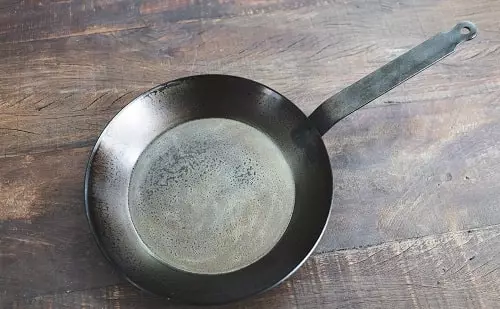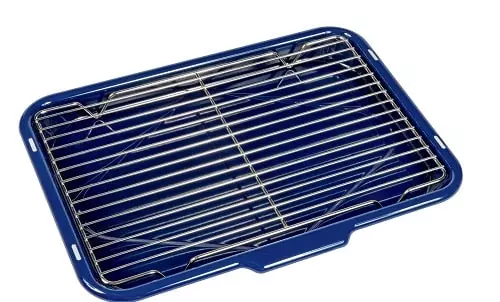Cast iron pans stand as iconic and enduring tools of the trade. Their ability to withstand high heat, distribute it evenly, and develop a natural non-stick surface over time has earned them a special place in kitchens around the globe. In this comprehensive guide, we will delve into the world of cast iron pans, exploring their definition, types, features, uses, and the multitude of benefits they bring to the culinary realm.
Understanding Cast Iron Pans:

A cast iron pan is a type of cookware made from cast iron metal. It is known for its exceptional heat retention, even heat distribution, and versatility in the kitchen. Cast iron pans are treasured for their durability and their ability to improve with age, developing a seasoned non-stick surface that enhances their cooking performance over time.
Types of Cast Iron Pans:
- Skillet or Fry Pan: This is the most common type of cast iron pan, featuring sloped sides and a flat, circular cooking surface. Cast iron skillets come in various sizes, from small ones for single servings to larger ones for family meals.
- Griddle: Cast iron griddles have a large, flat cooking surface, perfect for making pancakes, crepes, and grilling sandwiches. They often come with handles for easy flipping.
- Dutch Oven: A cast iron Dutch oven is a versatile, deep pot with a heavy lid. It’s excellent for slow-cooking, braising, roasting, and making soups and stews.
- Grill Pan: Cast iron grill pans have raised ridges that create attractive grill marks on food. They are ideal for indoor grilling of steaks, vegetables, and even sandwiches.
Key Features of Cast Iron Pans:
- Exceptional Heat Retention: Cast iron pans retain heat exceptionally well, allowing for even cooking and the maintenance of a consistent cooking temperature.
- Even Heat Distribution: The dense nature of cast iron ensures that heat is distributed evenly across the cooking surface, eliminating hot spots.
- Natural Non-Stick Surface: With proper seasoning and use, cast iron pans develop a natural non-stick surface that improves over time, making them ideal for frying and sautéing.
- Durability: Cast iron pans are built to last for generations, with proper care and maintenance.
- Versatility: Cast iron pans can be used on various heat sources, including stovetops, ovens, grills, and even over an open flame.
Uses of Cast Iron Pans:
- Searing: Cast iron pans are excellent for searing meats to perfection, creating a flavorful crust while keeping the interior tender and juicy.
- Frying: They are ideal for frying chicken, fish, and other foods, thanks to their ability to maintain a consistent and even temperature.
- Baking: Cast iron pans can be used in the oven for baking dishes like cornbread, deep-dish pizza, and cobblers.
- Roasting: You can use a cast iron skillet or Dutch oven for roasting vegetables, poultry, and other meats, achieving a lovely caramelization.
- Sautéing: The even heat distribution of cast iron makes it great for sautéing vegetables and creating flavorful pan sauces.
Benefits of Using a Cast Iron Pan:
- Excellent Heat Retention: Cast iron pans hold and distribute heat evenly, making them ideal for achieving consistent cooking results.
- Natural Non-Stick Surface: With proper seasoning and maintenance, cast iron pans develop a non-stick surface that improves with use, reducing the need for excess oil or fat.
- Versatility: Cast iron pans can be used on various heat sources, from stovetops to ovens, grills, and even campfires, making them suitable for a wide range of cooking techniques.
- Durability: Cast iron pans are known for their longevity and can last for generations with proper care.
- Affordability: They are often more affordable than other high-quality cookware and offer excellent value for the price.
Seasoning and Maintenance:
To maintain the non-stick surface and longevity of your cast iron pan:
- Seasoning: Season your pan by coating it with a thin layer of oil and heating it until it reaches its smoking point. Repeat this process several times to build up a natural non-stick patina.
- Cleaning: Avoid using soap, as it can strip away the seasoning. Instead, clean your pan with hot water and a stiff brush or scraper. Dry it thoroughly after washing to prevent rust.
- Re-Seasoning: If your pan loses its non-stick surface or shows signs of rust, you can re-season it by repeating the seasoning process.
In Conclusion:
A cast iron pan is a timeless and essential tool in the kitchen, beloved for its heat retention, even cooking, and natural non-stick properties. Whether you’re searing a steak, frying chicken, or baking cornbread, a well-seasoned cast iron pan is a versatile companion that can handle a wide range of culinary tasks. With proper care, it can become a cherished family heirloom, passing down the joy of cooking from one generation to the next. So, invest in a cast iron pan, and unlock a world of culinary possibilities as you cook with a piece of cookware that truly stands the test of time.

